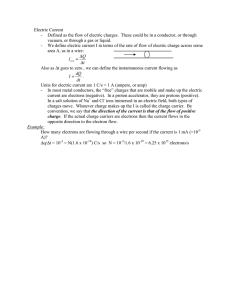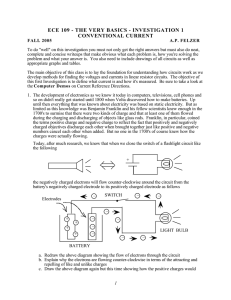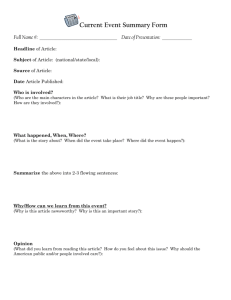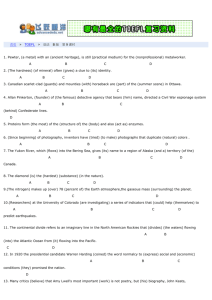Conventional Current
advertisement
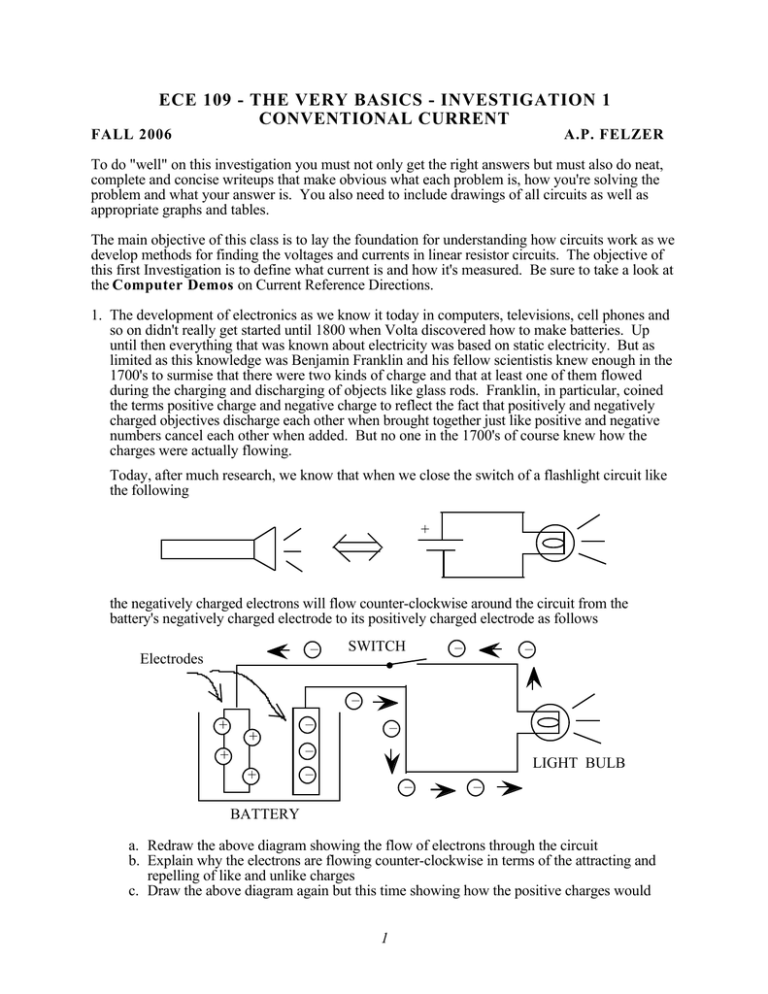
ECE 109 - THE VERY BASICS - INVESTIGATION 1 CONVENTIONAL CURRENT FALL 2006 A.P. FELZER To do "well" on this investigation you must not only get the right answers but must also do neat, complete and concise writeups that make obvious what each problem is, how you're solving the problem and what your answer is. You also need to include drawings of all circuits as well as appropriate graphs and tables. The main objective of this class is to lay the foundation for understanding how circuits work as we develop methods for finding the voltages and currents in linear resistor circuits. The objective of this first Investigation is to define what current is and how it's measured. Be sure to take a look at the Computer Demos on Current Reference Directions. 1. The development of electronics as we know it today in computers, televisions, cell phones and so on didn't really get started until 1800 when Volta discovered how to make batteries. Up until then everything that was known about electricity was based on static electricity. But as limited as this knowledge was Benjamin Franklin and his fellow scientistis knew enough in the 1700's to surmise that there were two kinds of charge and that at least one of them flowed during the charging and discharging of objects like glass rods. Franklin, in particular, coined the terms positive charge and negative charge to reflect the fact that positively and negatively charged objectives discharge each other when brought together just like positive and negative numbers cancel each other when added. But no one in the 1700's of course knew how the charges were actually flowing. Today, after much research, we know that when we close the switch of a flashlight circuit like the following + the negatively charged electrons will flow counter-clockwise around the circuit from the battery's negatively charged electrode to its positively charged electrode as follows – Electrodes SWITCH – – – + + – – – + + LIGHT BULB – – – BATTERY a. Redraw the above diagram showing the flow of electrons through the circuit b. Explain why the electrons are flowing counter-clockwise in terms of the attracting and repelling of like and unlike charges c. Draw the above diagram again but this time showing how the positive charges would 1 flow if they were the mobile charge carriers instead of the electrons d. How is the direction of the positive charge in part (c) related to the direction the negatively charged electrons are actually flowing 2. From Problem (1) we know that if the positively charged particles were the ones flowing in our resistor circuits then they would be flowing in the opposite direction of the electrons. We refer to this flow of positive charge as the flow of equivalent positive charge (epc). Equivalent positive charge is important because when scientists and engineers built the first meters to measure the flow of charge "they set things up" to measure the flow of equivalent positive charge. We call this conventional current. In particular for a conventional current I with reference arrow pointing from A to B as follows I A B (1) The magnitude of I tells us the rate at which equivalent positive positive charges are flowing in units of coulombs/sec or amps where a coulomb is the amount of charge Q on 6.28 × 1018 protons (2) The sign of I together with the direction of the reference arrow tells us the direction the equivalent positive charges - and therefore also the negatively charged electrons - are flowing Given all this, the objective of this problem is to figure out how scientists and engineers make use of both the sign of a current I and the direction of its reference arrow to specify the direction charges are flowing through wires. Here are two examples that illustrate what's going on. Note that each plus sign corresponds to 1A (1 amp) of current. Example 1 – For this flow of equivalent positive charge A + + + + B the currents I1 and I2 are I1 = 4A I2 = – 4A Example 2 – For this flow of equivalent positive charge A + + + + B the currents I1 and I2 are I1 = – 4A I2 = 4A Make use of these two examples to explain in words the relationship between the the sign of the current, the direction of the reference arrow and a. The direction the equivalent positive charges are flowing b. The direction negatively charged electrons are in fact flowing 3. Suppose 4 coul/sec of equivalent positive charge is flowing through a wire as follows 2 + A + + + B a. What is I equal to if we choose the reference direction as follows I A B b.What if the reference direction for I was chosen as I A B 4. Suppose 4 coul/sec of negatively charged electrons is flowing through a wire as follows A B a. What is I equal to if we choose the reference direction as follows I A B Hint - first draw the flow of equivalent positive charge b.What if the reference direction for I was chosen as I A B 5. How does the direction we draw the reference arrow affect the direction the equivalent positive charges are flowing through a given wire. Justify 6. Draw pictures of the equivalent positive charge in the following wire with arrows showing the direction of flow I A B a. If I = 6A b. If I = −6A 7. Draw pictures of the equivalent positive charge in the following wire with arrows showing the direction of flow I C D a. If I = 4A b. If I = −4A 8. Suppose an engineer measures the current I1 = 3A flowing through the following wire I1 A B 3 a. Draw a picture to illustrate the direction the equivalent positive charge is flowing b. Now suppose a second engineer measures the current through the same wire but with current reference arrow pointing in the opposite direction as follows I2 A B What would the second engineer measure for I2 . Explain how you got your answer. c. Express I1 as a function of I2 . Then describe in words how they're related. d. How, in general, does reversing the direction of a reference arrow affect the value of the corresponding current 9. What additional information do you need to be able to determine which way the equivalent positive charge is flowing through the following wire I A B 10. Explain why I1 + I2 = 0 in the following wire. This is really important to understand. I1 I2 11. Math Review: Sketch a graph of V = −2 + 4I 4
